| کد مقاله | کد نشریه | سال انتشار | مقاله انگلیسی | نسخه تمام متن |
|---|---|---|---|---|
| 254708 | 503325 | 2015 | 13 صفحه PDF | دانلود رایگان |
For the convenience of shoppers and users, there is an increasing demand for construction of basements in close proximity to existing tunnels. To ensure the safety and serviceability of existing tunnels, many numerical analyses have been conducted to investigate the basement–tunnel interaction. However, most of previous studies have simplified the complex interaction as a plane strain problem and often they have overlooked effects of stress path and strain dependency on soil stiffness. In this study, three-dimensional numerical parametric study is conducted to explore the complex interaction in dry sand by using an advanced hypoplastic soil model. The validity of the soil model and soil parameters is calibrated and verified by centrifuge test results. Parameters considered on tunnel responses by overlying basement excavation include excavation geometry, sand density, tunnel stiffness and joint stiffness. It is found that the basement–tunnel interaction at basement centre reaches a plane strain condition when excavation length along the longitudinal tunnel direction is longer than 9 He (final excavation depth). Both heave and transverse tensile strain of tunnel exceed the allowable movement limit and cracking strain when excavation length is longer than 5 He and excavation width is wider than 2 He. At a given excavation area on plan, the longer side of basement should be perpendicular to the longitudinal tunnel direction to reduce excavation induced adverse effects on existing tunnel. Because a looser soil has smaller stiffness around the tunnel, tunnel heave and tensile strain at basement centre are increased by up to 90% and 80%, respectively, when relative sand density decreases from 90% to 30%. By increasing tunnel stiffness 100 times, induced maximum tunnel heave and tensile strain are reduced by up to 75% and 85%, respectively. This means that stiffening a tunnel can be an effective way to alleviate excavation induced adverse effects on existing tunnel. Induced tunnel heave and tensile strain at basement centre are insensitive to the presence of tunnel joint unless the joint stiffness is less than 30% of the lining stiffness.
Journal: Computers and Geotechnics - Volume 63, January 2015, Pages 146–158
